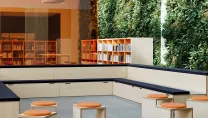Creating the ideal educational environment is more than just choosing furniture and colour schemes. It’s about designing a space that enhances learning, supports students, and creates an atmosphere where both students and staff can thrive.
Whether you’re planning an update or a complete overhaul, understanding the education fit out process ensures your design meets the needs of everyone who uses the space. The education interior design process helps transform schools, colleges, and universities into tailored spaces that inspire the next generation. Here, we’ll take you through the key steps involved, giving you insights into how to approach your next education fit out effectively.
1. Define the Project Scope
The first step in any successful education fit out is clearly defining your project’s goals. What does your institution need? What challenges are you trying to solve? Defining the scope involves identifying:
- The type of spaces you need (e.g. classrooms, labs, libraries)
- Specific requirements for both students and staff
- Capacity and functionality targets for each area
A thorough understanding of the institution’s needs is vital. Are there any accessibility requirements? Will technology integration play a key role? By addressing these questions early, you avoid common design pitfalls and ensure a focused approach from the start.
2. Conduct Research and Analysis
Before diving into design ideas, research is crucial. Investigate the latest trends in education interior design and evaluate how new developments could benefit your institution. You’ll want to consider:
- Space utilisation: Are there existing underused areas that could be improved?
- Furniture innovations: Consider ergonomic and adaptable furniture that can meet changing learning styles and technology. Think about the longevity of these pieces too to save future investment for elsewhere.
- Sustainability: Modern designs are moving towards eco-friendly materials and energy-efficient solutions.
Analysing your existing space is also key. What works well, and what doesn’t? How do people currently move through the building, and where can changes improve flow and functionality? Conducting a detailed assessment at this stage will set the foundation for a smooth design process. We’d recommend hosting a focus group or sending a survey out to staff and students to find out what they think would help them work best.
3. Develop a Design Brief
Once you have a clear understanding of what’s required, it’s time to develop a detailed design brief. This document outlines everything from goals to budgets, ensuring everyone involved is aligned. Your design brief should include:
- Project objectives and specific goals
- Budget estimates
- Timeline expectations
- Considerations for aesthetics, functionality, and technology integration
Think of the design brief as the roadmap for your education fit out. It guides the entire process and ensures nothing is overlooked.
4. Conceptual Design and Planning
This is where your vision begins to take shape. In this phase, interior designers will develop initial concepts, layouts, and themes based on your brief. This may involve creating:
- Mood boards to capture the overall feel of the space
- Colour schemes that promote a conducive learning environment
- Layout options that maximise space efficiency and functionality
- Technology requirements looking beyond just furniture
The conceptual design phase is an exciting one. It’s where creativity meets practicality, and you start to see how the final space could look.
5. Design Development
Once the initial concepts are in place, it’s time to refine them further. In the design development phase, the focus is on fleshing out the details, including:
- Selecting the right materials and furniture
- Refining the lighting and technology plans
- Ensuring safety, accessibility, and compliance with regulations
During this phase, collaboration with key stakeholders is essential. Input and consultation from teachers, students, and administrators ensures that the design caters to real-world needs and preferences.
6. Review and Approvals
Once the detailed design is finalised, it’s time for stakeholder review and approval. This is a crucial step, as any changes at this stage could impact timelines and budgets. During reviews:
- Present the design to stakeholders and gather feedback
- Make any necessary adjustments to align with the project’s goals
- Confirm that all compliance and safety requirements are met
Being open to constructive feedback is key here. Ensuring that all voices are heard can prevent costly revisions later on.
7. Implementation and Construction
After approval, the physical transformation begins. The implementation and construction phase is where your education fit out comes to life. Key steps here include:
- Hiring contractors and managing construction timelines
- Coordinating with vendors for furniture and technology installation
- Ensuring that the design is executed to plan
Project management is critical during this phase to keep everything on track. Regular check-ins and updates ensure that all components of your education fit out are completed as expected.
8. Final Inspection and Handover
With construction complete, the next step is a final inspection. This ensures that everything aligns with the original design and that there are no outstanding issues. Steps include:
- Conducting a walkthrough with stakeholders
- Identifying any minor adjustments or snagging work
- Handing over maintenance guides and ensuring users are familiar with the space
Once the final sign-off is complete, the space is ready to be used, but the process doesn’t end here...
9. Post-Occupancy Evaluation
The best designs are those that can adapt to real-world feedback. After the space is in use, a post-occupancy evaluation can provide invaluable insights into how well it functions. This involves:
- Gathering feedback from users (teachers, students, and staff)
- Identifying any issues or areas for improvement
- Making necessary adjustments to optimise the space
Education fit outs are often about long-term performance. By checking in with users, you ensure that the space continues to meet their needs effectively.
10. Ongoing Maintenance and Updates
No educational space is static. Over time, wear and tear, evolving technology, and new teaching approaches mean that regular updates are essential. Ongoing maintenance ensures that your space remains functional and appealing. Some points to consider:
- Schedule regular checks for equipment and furniture
- Plan for future updates as educational needs evolve
- Stay updated on new trends and innovations in education fit outs
Keeping your spaces flexible and adaptable ensures they remain relevant in the years to come.
A successful education interior design process involves careful planning, research, and collaboration at every stage. From defining the project scope to conducting post-occupancy evaluations, each phase is essential in creating a learning environment that is both inspiring and functional. By following these steps, you can transform your educational spaces into hubs of creativity, learning, and innovation.
Are you ready to rethink your learning environment? Contact us today to discover how our tailored education fit out solutions can help you achieve your goals.





